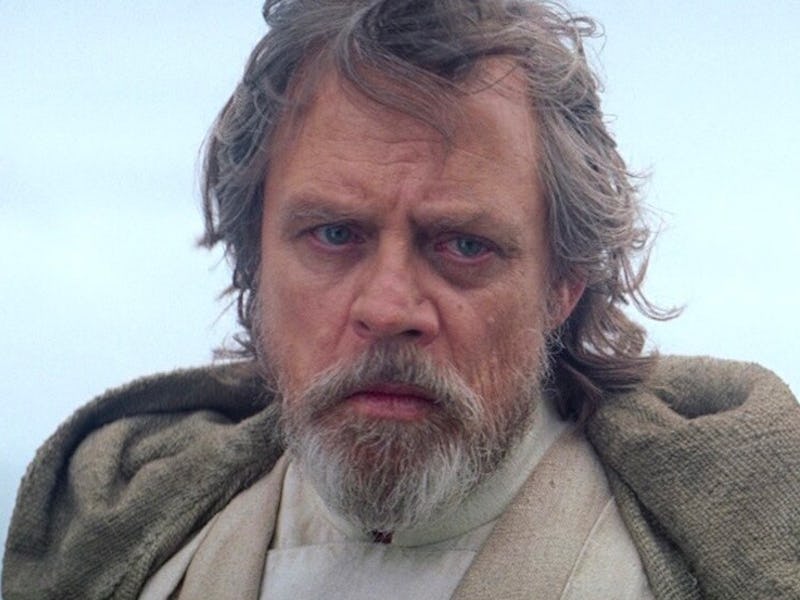Mark Hamill Just Acknowledged One of Lucasfilm’s Worst Habits
No one’s ever really gone, unfortunately.

When Luke Skywalker became one with the Force in The Last Jedi, it should have been the end of an era. His sacrifice was bittersweet, of course, but it also felt inevitable. We can’t expect these characters to live forever, or the actors that play them to keep doing so. As Star Wars has demonstrated time and again, nobody lives forever — and no actor should be stuck playing the same role for all eternity.
Mark Hamill, at least, seemed perfectly content to let go of Luke. “When I read The Last Jedi's script, I said, ‘OK, well, that's it for me,’” the actor recently told Esquire. “You start that process of disengaging from something that's been a part of your life.”
That process has since been halted by Lucasfilm’s growing obsession with nostalgia and, in a way, “realism.” Exactly three years after Luke made his noble sacrifice in The Last Jedi, The Mandalorian brought Hamill back, just in a very different capacity. With the help of startling CGI and a much younger body double, Hamill was able to return as Luke Skywalker. The technology wasn’t perfect — in fact, it was downright distracting — but Lucasfilm and its partners at Industrial Light and Magic have been working hard to make it seamless ever since. And in the process, they’ve set a dangerous precedent, one that Hamill himself is speaking out about now.
Mark Hamill returned as Luke Skywalker in The Mandalorian.
Hamill has “returned” as Luke twice already — once for The Mandalorian and again in The Book of Boba Fett — but even he seems to have his reservations about the de-aging process. By demonstrating that he can, in a way, be restored to a bygone image, many now expect to see a whole lot more uncanny-valley Luke in the future.
“People say, ‘Oh, now you’re going to be able to do a whole series of Luke post-Return of the Jedi,’” Hamill continued. “I said, ‘I don’t think so. First of all, they don’t need to tell those stories, but if they do, they could get an age-appropriate actor.”
And for the record, Lucasfilm already has a few on standby. Two actors, in particular, have stood in for a younger Luke. Max Lloyd-Jones served as Hamill’s double in The Mandalorian, while Graham Hamilton stepped in for The Book of Boba Fett. Both bear an uncanny resemblance to Hamill even before the visual effects teams get involved, but Lucasfilm remains dogged in its pursuit of eternal life.
In some ways, this shouldn’t be surprising. Lucasfilm and ILM have always pushed the boundaries of what’s possible on-screen, from the LED soundstages that made green- and bluescreens a relic to the uncanny motion capture tech that allowed older (or deceased) actors to “cameo” in new projects like Rogue One: A Star Wars Story. Peter Cushing’s and Carrie Fisher’s likenesses were used to feature Grand Moff Tarkin and Princess Leia in the 2016 film. Even then, fans pushed back on the inherent creepiness of that, but Rogue One felt like a contained experiment. Or, at the very least, a one-time thing, we hoped.
Now, this practice has become an unfortunate Star Wars fixture, and it’s even bled into other Lucasfilm projects. Indiana Jones and the Dial of Destiny will feature a de-aged Harrison Ford in a 25-minute flashback, a choice that critics have already begun to take issue with. It’s getting harder and harder to justify the de-aging process. At best, it’s a distracting, unnecessary new practice. At worst, it takes opportunities away from younger actors.
Recasting shouldn’t be a dirty word, especially not with all the success it’s brought to Lucasfilm in the past. Ewan McGregor breathed new life into Obi-Wan Kenobi decades after Alec Guinness originated the role. Despite Lucasfilm’s attitude towards Solo, the film gave us two great performances from Donald Glover and Alden Ehrenreich. Heck, Emperor Palpatine became the force we recognize today because of Ian McDiarmid. (Palps was originally portrayed by Marjorie Eaton in a mask and voiced by Clive Revill, with some chimpanzee eyes superimposed on top for good measure.)
Recasting is one of the few ways Star Wars has survived these past 40 years. If one of the franchise’s original stars can understand that, then it shouldn’t be that hard for Lucasfilm to accept.